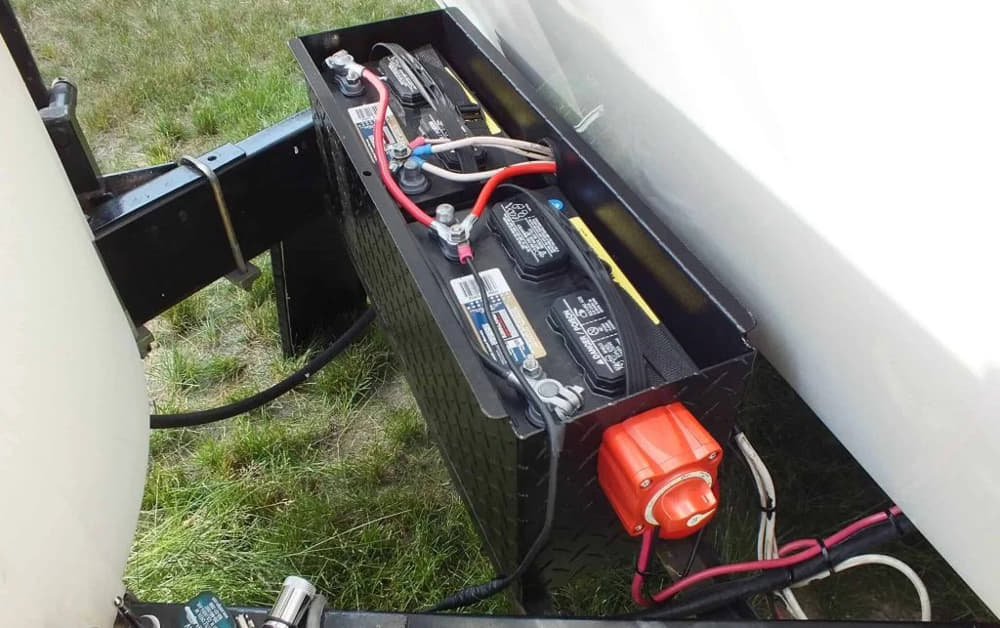To disconnect the battery, first remove the cable from the negative terminal of the battery. Next, remove the cable from the positive terminal.
One thing that many people don’t know about their trailer is that when you unhook your trailer, you should disconnect your battery. The reason for this is that if you don’t, and you have a power outage at home or just forget to turn off your lights and appliances, they will drain your battery while it’s not hooked up to anything.
Should I disconnect my travel trailer battery?
If you leave your RV battery plugged in after it’s fully charged, it can deplete the cells’ electrolyte levels. This can lead to reduced battery life unless you have a newer RV converter with a three or four-stage charging process called a smart charger or if you’ve attached a battery tender.[1]
Where is the battery disconnect on a travel trailer?
As implied by the name, an RV battery disconnect switch provides you with a simple way to cut off the main RV circuit from your battery. Typically, this switch is located near your battery inside the battery compartment, but it may also be in a nearby maintenance bay.[2]
Do I disconnect the red or black first?
When removing the old battery, remember to first disconnect the cables from the negative terminal, which is usually black and has a minus (-) sign then disconnect the cables from the positive terminal, which is usually red and has a plus (+) sign.[3]
Are you supposed to disconnect positive or negative first?
The terminals will be marked positive and negative. Make sure you disconnect the negative terminal first. Lay the disconnected negative cable carefully to one side, making sure it’s well away from the battery terminal.[4]
Should I disconnect my RV battery when plugged into shore power?
Normally you should leave the Battery Disconnect Switch on when your RV is connected to shore power. Most RVers only turn off the battery disconnect switch when they are storing their RVs for longer periods of time and they are not hooked up to shore power to help eliminate drain on their house battery system.[5]
Is it OK to leave travel trailer plugged in all the time?
Yes, you can keep your Travel Trailer plugged in all of the time. One of the things you need to monitor is the house batteries for the trailer. Since the house batteries will be receiving a constant charge, you need to monitor the electrolyte levels in the house batteries.[6]
Should I disconnect my travel trailer battery for winter?
When you store your RV during the offseason, you also need to remove your battery and keep it in a warm location. If you leave it in, the water in your battery may freeze when the temperature drops too low. This happens because a battery loses its sulfuric acid when it discharges and leaves water behind.[7]
Will battery still charge with solar panel when battery disconnect is turned off?
When master power switch is off, does the solar panels still charge the batteries? The solar panels are wired directly to the house batteries, completely bypassing the main battery disconnect. As long as you have sunshine up above, your batteries will continue to charge![8]
Can you overcharge a camper battery?
Overcharging your RV batteries can result in severe water loss, plate corrosion, and eventual failure. Most RVs have a converter with a built-in battery charger. Many RV owners assume that chargers will keep the batteries topped off if you keep the RV plugged in while it’s in storage.[9]
Can I run my RV without a power converter?
Do I Need an RV Power Converter Even When Connected to Shore Power? Yes, you do, indeed. Without a working RV power converter (or charger) onboard, your batteries would drain and you wouldn’t be able to use any of your rig’s 12V accessories or appliances.[10]
Does my travel trailer battery charge while driving?
While the engine is running, the alternator continuously charges the starting battery. Second, the RV’s house/service battery or battery bank (typically deep cycle batteries) run everything electrical in your living space when you aren’t plugged into shore power.[11]
What happens if you remove the positive terminal first?
It’s important to disconnect the negative side of the battery first, otherwise you can cause an electrical short if the positive is removed first.[12]

